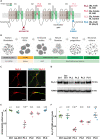Pathogenic SCN2A variants cause early-stage dysfunction in patient-derived neurons
- PMID: 37010102
- PMCID: PMC10281746
- DOI: 10.1093/hmg/ddad048
Pathogenic SCN2A variants cause early-stage dysfunction in patient-derived neurons
Abstract
Pathogenic heterozygous variants in SCN2A, which encodes the neuronal sodium channel NaV1.2, cause different types of epilepsy or intellectual disability (ID)/autism without seizures. Previous studies using mouse models or heterologous systems suggest that NaV1.2 channel gain-of-function typically causes epilepsy, whereas loss-of-function leads to ID/autism. How altered channel biophysics translate into patient neurons remains unknown. Here, we investigated iPSC-derived early-stage cortical neurons from ID patients harboring diverse pathogenic SCN2A variants [p.(Leu611Valfs*35); p.(Arg937Cys); p.(Trp1716*)] and compared them with neurons from an epileptic encephalopathy (EE) patient [p.(Glu1803Gly)] and controls. ID neurons consistently expressed lower NaV1.2 protein levels. In neurons with the frameshift variant, NaV1.2 mRNA and protein levels were reduced by ~ 50%, suggesting nonsense-mediated decay and haploinsufficiency. In other ID neurons, only protein levels were reduced implying NaV1.2 instability. Electrophysiological analysis revealed decreased sodium current density and impaired action potential (AP) firing in ID neurons, consistent with reduced NaV1.2 levels. In contrast, epilepsy neurons displayed no change in NaV1.2 levels or sodium current density, but impaired sodium channel inactivation. Single-cell transcriptomics identified dysregulation of distinct molecular pathways including inhibition of oxidative phosphorylation in neurons with SCN2A haploinsufficiency and activation of calcium signaling and neurotransmission in epilepsy neurons. Together, our patient iPSC-derived neurons reveal characteristic sodium channel dysfunction consistent with biophysical changes previously observed in heterologous systems. Additionally, our model links the channel dysfunction in ID to reduced NaV1.2 levels and uncovers impaired AP firing in early-stage neurons. The altered molecular pathways may reflect a homeostatic response to NaV1.2 dysfunction and can guide further investigations.
© The Author(s) 2023. Published by Oxford University Press. All rights reserved. For Permissions, please email: journals.permissions@oup.com.
Figures





References
-
- Hu, W., Tian, C., Li, T., Yang, M., Hou, H. and Shu, Y. (2009) Distinct contributions of Nav1.6 and Nav1.2 in action potential initiation and backpropagation. Nat. Neurosci., 12, 996–1002. - PubMed
-
- Martínez-Hernández, J., Ballesteros-Merino, C., Fernández-Alacid, L., Nicolau, J.C., Aguado, C. and Luján, R. (2013) Polarised localisation of the voltage-gated Sodium Channel Nav1.2 in cerebellar granule cells. Cerebellum, 12, 16–26. - PubMed

